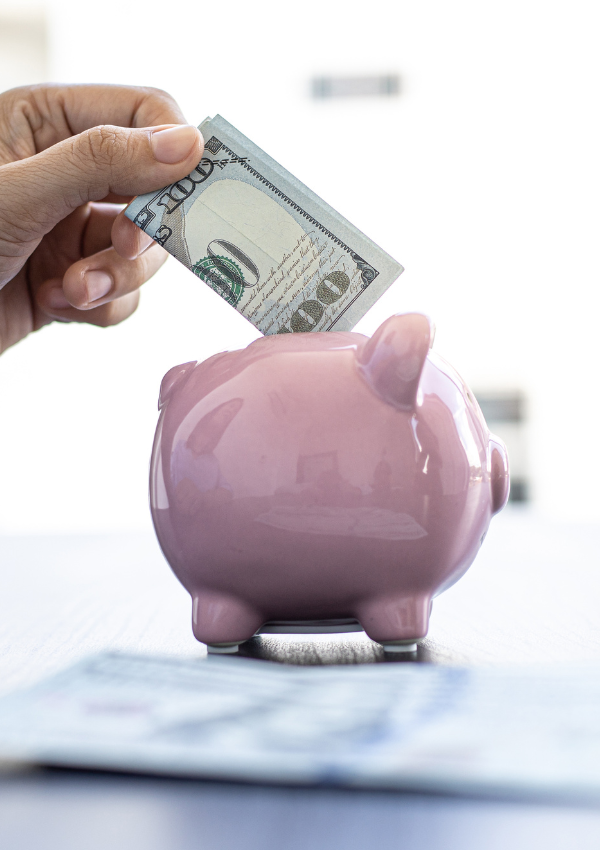
Are you looking to change your financial picture for 2025? Do you want to save, but are struggling? Are you tired of hearing everyone (including me) telling you to start a budget?
While I do believe a budget is the best way to save money, I know many struggle with them and are looking for different ways to save money.
If you’re looking for how to start a budget for beginners, check here. If you already have your budget set, or you want to save money but can’t seem to stick with a budget, here are 9 actionable steps you can take to save money this year.
Automation

Automate, automate, automate. There’s really not much more I can say here. Automating your savings into a separate account is the absolute best and easiest way to grow your savings.
This simple method involves very little startup and can help you make your savings dreams come true.
There are a couple of different ways to automate your savings, depending on your personal situation.
- Direct deposit – Many employers, like mine, allow their employees to use direct deposit to transfer funds from their paycheck directly to their bank account of choice. In addition, many employers allow you to transfer to multiple different accounts. This allows you to have a set amount from your paycheck automatically deposited into a savings account.
- Bank transfers – If you don’t have the opportunity for direct deposit, whether your employer does not allow it, or you are self employed, bank transfers are your best option. I have yet to meet a bank that does not allow automatic transfers. With this feature, you can set your checking account to automatically transfer funds out of it on a day of your choosing, say, on the day after your paycheck? This way, the money is moved into a savings account before you even notice it.
Best tips and advice for automated savings:
- Be cognizant about how much you can afford to save. Don’t let yourself get caught in a situation where you have to pay over draft fees because you don’t have enough in your checking account. To prevent this, be aware of your finances and keep a small buffer amount in your checking account.
- Keep the savings account separate from your other accounts. This is probably the most important tip. Out of sight, out of mind is real. If you see the money, you will spend it. Create a completely separate savings account, preferably at a different bank, so you’d have to wait a bit of time for the transfers. This helps prevent you from easily transferring your money back for frivolous spends
- Don’t check your account regularly. It can be both discouraging and difficult to keep checking your savings account balance to see how much it has gone up. Trust me, if you have done the work and have money automatically going into the account, it will go up. You may be tempted to log in regularly to see the total, but in the beginning, the small amount may discourage you, and later on, it will make it difficult to not want to spend the money
Overall, automated savings is my favorite tool to increase my savings. Give it a try – you’ll be surprised how fast your money can grow.
Shop Smarter

There are some financial gurus out there that scoff at things like couponing or bargain shopping to save money. They claim that the $5 a week you could save isn’t worth it. Is it? Imagine you save $5 in groceries each week. You invest that $20 a month. At a 6% return, in 30 years you would have invested $7200 total, but would have $19,528. Imagine doing that with $10 a week. $20? What if you combined that with the other tips in this article? Now you can see how your wealth can grow!
Here are some tips for smarter shopping to help you save money this year:
- Coupons – now I’m not asking you to become an extreme couponer, but you would be amazed at how many coupons there are for items you are already buying. I save $4 a month on Cheerios alone. Check out the popular site coupons.com for a whole bunch of printable coupons. A site like KrazyCouponLady is a great resource for a newbie couponer. And don’t forget to keep an eye out for digital coupons at stores your shop. I got a 64oz laundry detergent from Walgreens for only $3 by combining an in-store promotion with a coupon
- Buy store brand – Don’t knock it til you’ve tried it. Seriously. Most store brand stuff tastes just as good as name brand, and some stuff is even better. If you’re unsure, try starting with items you might mix in to a recipe. For example, if you’re making a green bean casserole recipe, trying buying store brand green beans. Trust me, you won’t notice the difference and you’ll save some significant cash over the course of a year.
- Digital savings apps – Digital savings apps like Ibotta and Fetch give you cash back on your purchases for qualifying purchases. Before heading into a store, do a quick browse of these sites, see what can earn you some cash, and be sure to scan your receipt after you’ve finished shopping. It’s as easy as that.
- Cashback sites/apps – Common sites like Rakuten and TopCashBack help you get a small reimbursement when you spend money at sponsored sites. To get your cashback, it’s only one extra step from what you’re already doing. Let’s say you need to place an order at Lowe’s. Head over to Rakuten, create a free account, and search for Lowe’s. Once you are directed to Lowe’s home site, place your order, and Rakuten will give you cash back for your order! It’s as easy as that.
Shopping smarter can be difficult and time consuming. I recommend not letting yourself get overwhelmed. Pick a couple of sites and make them your staples. Don’t spend hours searching for fifty cents less of a deal. It’ll drive you crazy, and it’s not worth it. Spend just a small amount of time searching for deals and watch your extra money roll in.
Cancel Subscriptions

I feel like this is one of those tips a lot of people recommend but people are always hesitant to do. Why? Because they might use that something soon, or they promise they are going to. Well here’s my advice. Stop being lazy and just cancel the subscription.
If you are really, really convinced you will start using it, I’ll cut you a deal. Put a reminder in your phone for two months from now. If you still haven’t used that subscription for at least what it’s worth, it gets canceled. That means if you only watched your Paramount App once in two months, you don’t get to keep it. It’s not worth it. If you only went to the gym three times in those two months, say bye bye to your gym membership.
Stop thinking about the what ifs and some days. Even if you used to enjoy the subscription, but you do not any more, it’s time to let it go.
Let me tell you a story about one of my coworkers. She spends $180 a month on subscriptions, most of them on her TV. I asked her if she uses them all and she admitted she does not. I advised her to cancel most, if not all of them, and she said she couldn’t do that. Then, I advised that she should cancel all but one, watch the shows on that subscription for a month or two, and then cancel it and get one of the other one’s. She said she can’t do that because one day she “might” want to watch a show on one of the other channels. I bet a lot of you have made the same excuse before. COME ON people. Cancel the subscription. That’s a lot of money wasted over maybe’s that aren’t even happening.
Do yourself and your finances a favor, and get rid of the subscriptions you never use. When I finally decided to let go, I saved almost $65 a month.
Let’s do our same math as before. With the $20 I saved on groceries and the $65 I’m saving on subscriptions, I now have $85 to invest each month. Over the same 30 years, I will have invested a total of $30,600. And at the same 6% return, I will have $82,833. Just from cutting out a few subscriptions I don’t use and clipping some coupons, I can add $82,833 to my retirement. Not too shabby.
High-Yield Savings Account

If you haven’t made the switch to opening up a High-Yield Savings Account, well, then, all I’ll say is that you need to. Right now. Anyone that is earning less than 1% on a savings account instead of the current 4% is completely missing out on 3% of interest. Don’t think that’s much? I made over $100 on interest last year in just my savings account. How much did you make?
Bonus points to you if you set up automated savings transfers and have it sent to a high-yield savings account.
Some of the best one’s out there are:
- Capital One
- Amex
- Marcus by Goldman Sachs
These accounts only take a few minutes to set up, and within no time at all you can be earning a significantly higher interest rate than your current account.
Don’t slack off on this! There isn’t much that’s free out there, but earning 4% rather than %0.50 sounds like a good deal to me.
Negotiate Bills

Another piece of advice that falls to the wayside for the lazy. Most people I talk to are either too scared (I’m not sure of what?) or say they’ll ‘get to this later,’ but then later never comes. One person told me they were afraid of the rejection. From who? A random person thousands of miles away who you’ll never talk to again? If your answer is yes, I have a bit of advice for you. Write up a script. If you can’t think of one on your own, use an AI like ChatGPT to write one for you. It’ll make you feel more comfortable and it will be easier to answer the questions.
Not every bill negotiation is successful, but I always say it’s worth at least a ten minute phone call to try.
The first year I bought my house, I tried to negotiate my cable bill. I knew the company had lowered my parent’s before so I called several times and talked to different reps. No luck. Two DAYS after I turned my box in, I got a mailer offering me a comeback promo at the same price I had been paying.
What are some of the best bills to try to negotiate?
- Electric – did you know you don’t have to go with the electric service company in your area? Try calling your local service company, and if they won’t budge, look around for other options. Consider switching companies, or looking for a solar farm community company that helps reduce your bill.
- Gas bill – Once again, yes, it is possible to negotiate your utility bills. It may be more difficult, as they are not trying to sell you a service, but it is possible. Start by saying you would like to discuss your plan and explore available options. Be polite but persistent during your conversation.
- Phone bill- I’ll give you a hint here. Phone companies want to keep you. That’s why you constantly see deals adding up to hundreds of dollars. I have personally never negotiated a phone bill, as my family is locked into a great plan that no longer exist, but I have heard tons of successful stories from others who have. Give it a try and see if they’ll give you some sort of retention offer
- Cable bill- Lately it seems like cable companies aren’t as negotiable as they used to be. You think they’d be clinging to customers with all of the streaming services available, but it doesn’t appear to be that way. I previously mentioned that I was unsuccessful at negotiating my cable bill, but I still think it’s worth a shot. You do have to be prepared to potentially give up your cable entirely, or keep paying what you are.
- Wi-Fi – With all of the internet options available, Wi-Fi negotiation is easier than ever. As long as you have a couple of other internet providers available at your address, you will very likely be offered a retention offer to help lower your Wi-Fi cost.
These are just some of the many types of bills that you can negotiate. Don’t be afraid to talk to the company representatives. For some of them, it’s their job to give you offers and keep you with the company.
Get creative with your bills. Every little reduction helps.
Embrace DIY

I’m not saying you have to go full DIY on every project, but when trying to save money, DYI is the way to go. Last year I saved $4000 on learning to install flooring at one of my rental properties. Not only was it not as hard as I thought, but I now have a new skill!
Tips for DIY:
- Start small – you don’t need to learn how to plumb an entire house. But you could learn how to put in a new sink. YouTube and blogs have made it easier than ever to learn a new skill. It doesn’t even have to be in home repair! Learn to knit some Christmas gifts, or bake for a birthday rather than buying a cake. It will save you a ton of money.
- Know your strengths – Sometimes, there are just things we cannot do. DYI is great, but if something is beyond your skill level, or just not your strong suit, don’t waste your time on it. A botched job will only be more expensive in the long run
- Ask for help – don’t be afraid to ask friends or family to help you. A lot of people feel like they’re burdening people in their life. Guess what? That’s what they’re for! The people around you are your community. If you think they can help you save time and money, ask for help. Just be sure to return the favor!
DIY can be both fun and daunting. It can also be rewarding. I use DIY all the time to save money and take care of my space.
Declutter

How does decluttering save you money if you’re just getting rid of stuff? In a couple of ways!
First of all, decluttering is good for you! Generally, when you have too much stuff and you get rid of it, you feel better. Having too much stuff and too much clutter can make us feel claustrophobic in our own homes.
One way decluttering helps you save money is by encouraging you to buy less in general. If you commit to decluttering and keeping it that way, it will be easier to resist the urge to buy things we don’t need. This helps us save money overall and prevent our homes from filling with needless things.
Another way decluttering could help you save money is by selling some of the items. Depending on the condition and need of the items you’re removing, you could sell them on places like Craigslist and Facebook Marketplace. Take the little extra bit of cash you made and put it in your savings! Boom! Additional money saved and your house is less cluttered. Win win.
Energy Efficiency

Becoming energy efficient can save you a lot more than you might realize. The first few years I lived in my house, I paid an average of $80 per month for my gas bill. One day I realized the house had a thermostat had a schedule feature. Now I have the temperature drop while I’m at work and at night. My current gas bill per month? $60. Yup, that’s right. I’m saving $20 per month. That’s hundreds of dollars wasted over those several years to keep my house nice and cozy while I wasn’t even home. Yes, I’m still smacking myself in the forehead.
Looking for other ways to save through energy efficiency? Here’s a few!
- Energy efficient bulbs – now I wouldn’t just go change all of your light bulbs just to be energy efficient. That would be a waste of money. But as your bulbs die, replace them with energy efficient bulbs. Your electric bill will thank you
- Energy Star appliances – These appliances are literally designed to use less energy. They are just efficient as your old machine and will help you save on utility bills!
- Insulation – if you have an older house and are doing any work that requires the walls to be open, I highly recommend you pump some insulation in there before closing them back up. It will save you significantly in energy consumption and keep your home warmer in the cold months.
- Control your water heater – a couple of simple ways to save on your water tank are to add an insulated sleeve on the outside to conserve the hot water, and to put the water heater on a timer. This helps keep your hot water longer and lower your gas bill.
- Clean your air filters – this is one mundane task I’m always trying to avoid. The truth is, not only is it better for your health, but it’s also more energy efficient. Clogged filters make your air conditioner and furnace work harder, making them use uo more energy.
- Get more efficient furnaces/water tanks – again, I wouldn’t go out and buy a new furnace if yours is still fine. However, if your furnace is breaking, I recommend checking out your options and splurging on a more energy efficient option. As of the writing of this article, there are state and federal incentives for buying certain energy efficient devices, helping save you even more money.
Becoming energy efficient is beneficial to you, your wallet, and the environment. Making the changes above can be done slowly and over time. Small changes can have a big impact on your future.
Delay Non-Essential Purchases

An amazing way to save money is by…not buying things. Sounds easy right? It’s not. Even with a budget, it’s easy to let indiscretionary spending get out of hand. So how can we put a stop to it?
There is a method where you wait to make the purchase as long as it is a non-essential item. Let’s say you already have a phone charger, but there’s a cool wireless one you want and it’s “only a few bucks.” When you make purchases like this over and over and over again, it does add up. Quickly. Instead, try delaying the purchase.
I have seen different time frames for the delay, but the one that seems to work for me is 48 hours. If I see an item I want, I wait 48 hours before purchasing.
The first time I tried this, I was amazed how easily I forgot about the item. The next time, I still remembered I wanted the item, but the strong desire for it was gone. It no longer felt like an urgent need. So I didn’t buy.
Let me make this concept clear. If you can stop yourself from buying something you don’t need, you have essentially saved that money. The money can now be used for other purposes, since it didn’t disappear into the black hole of impulse spending.
Not sure if you can do it? Give it a try, at least once, and see what happens. Print out a photo of the picture or screenshot it, so you can look back and remind yourself what you wanted. If the impulse to buy is gone, don’t.
Conclusion

Saving money doesn’t have to be hard. Small, slow changes to your habits and lifestyle can have lasting results. Let’s go back to our original example, but now we’ve saved $20 a month on our gas bill and $30 a month by not spending on non-essential items. We also saved $15 on our phone bill, and save about $20 a month by doing our own small repairs. That’s an extra $85 a month to invest. I now have $170 a month to invest. Over 30 years, that’s $61,200 invested. At a 6% return, you now have…$165,677.
That’s a huge amount of money, for a small amount of change. Be cognizant about your savings and what you can do. Don’t be afraid to make some phone calls or try your hand at something new. It will be hard at first, but it will be so worth it.




